Edinburgh Napier University: Managing Organizational Change Report
VerifiedAdded on 2022/08/16
|22
|5714
|18
Report
AI Summary
This report delves into the complexities of managing organizational change, focusing on a case study of a line manager, Mr. Simon, who experienced demotivation due to lack of promotion despite his long service and diligence. The report explores key issues influencing motivation, job satisfaction, and employee commitment, examining their interrelationships. It discusses various theoretical approaches to motivation, including Maslow's Hierarchy of Needs, Equity Theory, and McGregor's X and Y theories, highlighting their practical applicability. The report also analyzes the role of leadership in organizational change, outlining leadership traits and their impact. It explains leadership theories such as Transformational, Situational, and Democratic leadership, and provides recommendations to re-motivate employees. The analysis emphasizes the importance of addressing factors like poor leadership, workplace conflict, and limited growth opportunities to foster a positive and productive work environment. The report concludes with a discussion of the practical limitations of leadership theories and suggests strategies for managers to improve employee motivation and satisfaction.
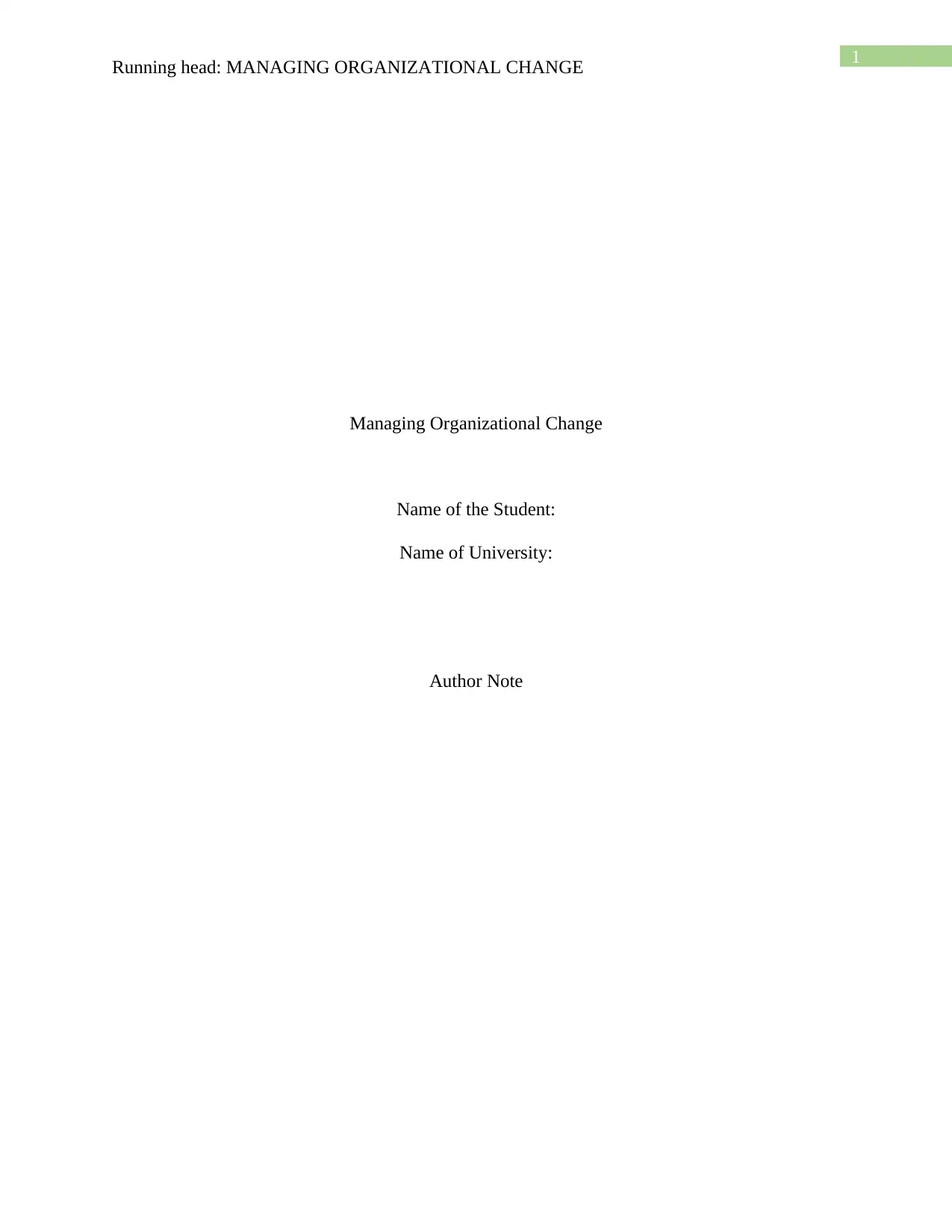
1
Running head: MANAGING ORGANIZATIONAL CHANGE
Managing Organizational Change
Name of the Student:
Name of University:
Author Note
Running head: MANAGING ORGANIZATIONAL CHANGE
Managing Organizational Change
Name of the Student:
Name of University:
Author Note
Paraphrase This Document
Need a fresh take? Get an instant paraphrase of this document with our AI Paraphraser
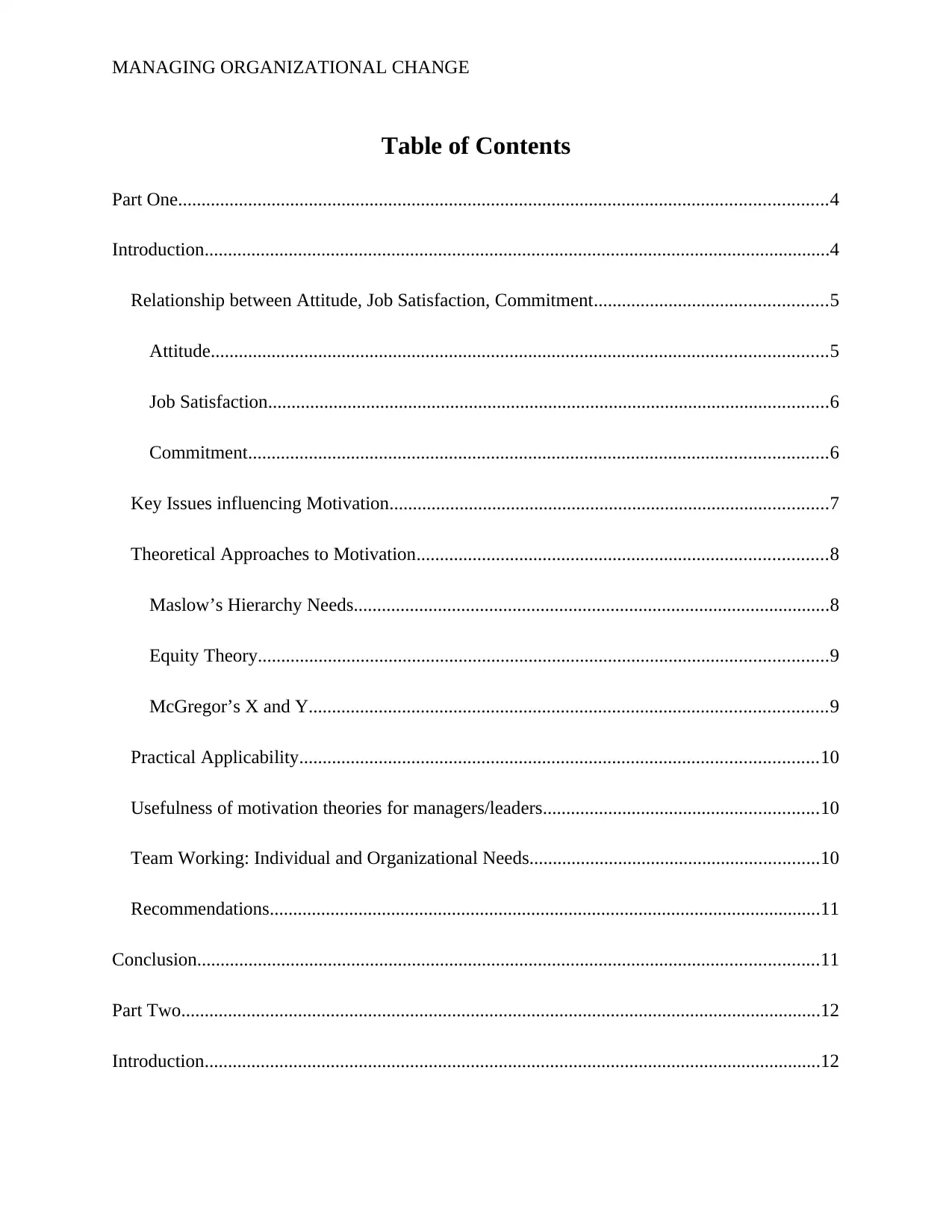
MANAGING ORGANIZATIONAL CHANGE
Table of Contents
Part One...........................................................................................................................................4
Introduction......................................................................................................................................4
Relationship between Attitude, Job Satisfaction, Commitment..................................................5
Attitude....................................................................................................................................5
Job Satisfaction........................................................................................................................6
Commitment............................................................................................................................6
Key Issues influencing Motivation..............................................................................................7
Theoretical Approaches to Motivation........................................................................................8
Maslow’s Hierarchy Needs......................................................................................................8
Equity Theory..........................................................................................................................9
McGregor’s X and Y...............................................................................................................9
Practical Applicability...............................................................................................................10
Usefulness of motivation theories for managers/leaders...........................................................10
Team Working: Individual and Organizational Needs..............................................................10
Recommendations......................................................................................................................11
Conclusion.....................................................................................................................................11
Part Two.........................................................................................................................................12
Introduction....................................................................................................................................12
Table of Contents
Part One...........................................................................................................................................4
Introduction......................................................................................................................................4
Relationship between Attitude, Job Satisfaction, Commitment..................................................5
Attitude....................................................................................................................................5
Job Satisfaction........................................................................................................................6
Commitment............................................................................................................................6
Key Issues influencing Motivation..............................................................................................7
Theoretical Approaches to Motivation........................................................................................8
Maslow’s Hierarchy Needs......................................................................................................8
Equity Theory..........................................................................................................................9
McGregor’s X and Y...............................................................................................................9
Practical Applicability...............................................................................................................10
Usefulness of motivation theories for managers/leaders...........................................................10
Team Working: Individual and Organizational Needs..............................................................10
Recommendations......................................................................................................................11
Conclusion.....................................................................................................................................11
Part Two.........................................................................................................................................12
Introduction....................................................................................................................................12
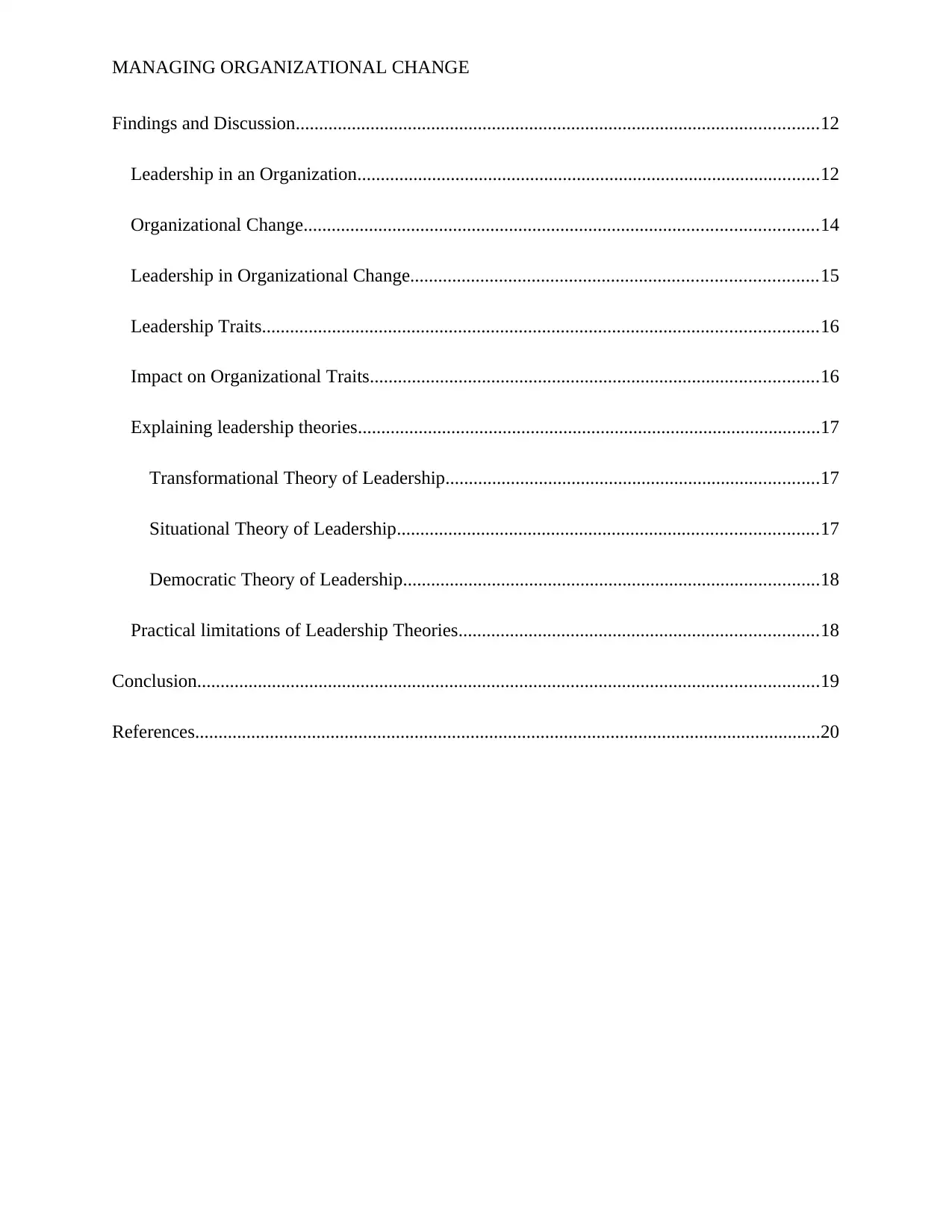
MANAGING ORGANIZATIONAL CHANGE
Findings and Discussion................................................................................................................12
Leadership in an Organization...................................................................................................12
Organizational Change..............................................................................................................14
Leadership in Organizational Change.......................................................................................15
Leadership Traits.......................................................................................................................16
Impact on Organizational Traits................................................................................................16
Explaining leadership theories...................................................................................................17
Transformational Theory of Leadership................................................................................17
Situational Theory of Leadership..........................................................................................17
Democratic Theory of Leadership.........................................................................................18
Practical limitations of Leadership Theories.............................................................................18
Conclusion.....................................................................................................................................19
References......................................................................................................................................20
Findings and Discussion................................................................................................................12
Leadership in an Organization...................................................................................................12
Organizational Change..............................................................................................................14
Leadership in Organizational Change.......................................................................................15
Leadership Traits.......................................................................................................................16
Impact on Organizational Traits................................................................................................16
Explaining leadership theories...................................................................................................17
Transformational Theory of Leadership................................................................................17
Situational Theory of Leadership..........................................................................................17
Democratic Theory of Leadership.........................................................................................18
Practical limitations of Leadership Theories.............................................................................18
Conclusion.....................................................................................................................................19
References......................................................................................................................................20
⊘ This is a preview!⊘
Do you want full access?
Subscribe today to unlock all pages.

Trusted by 1+ million students worldwide
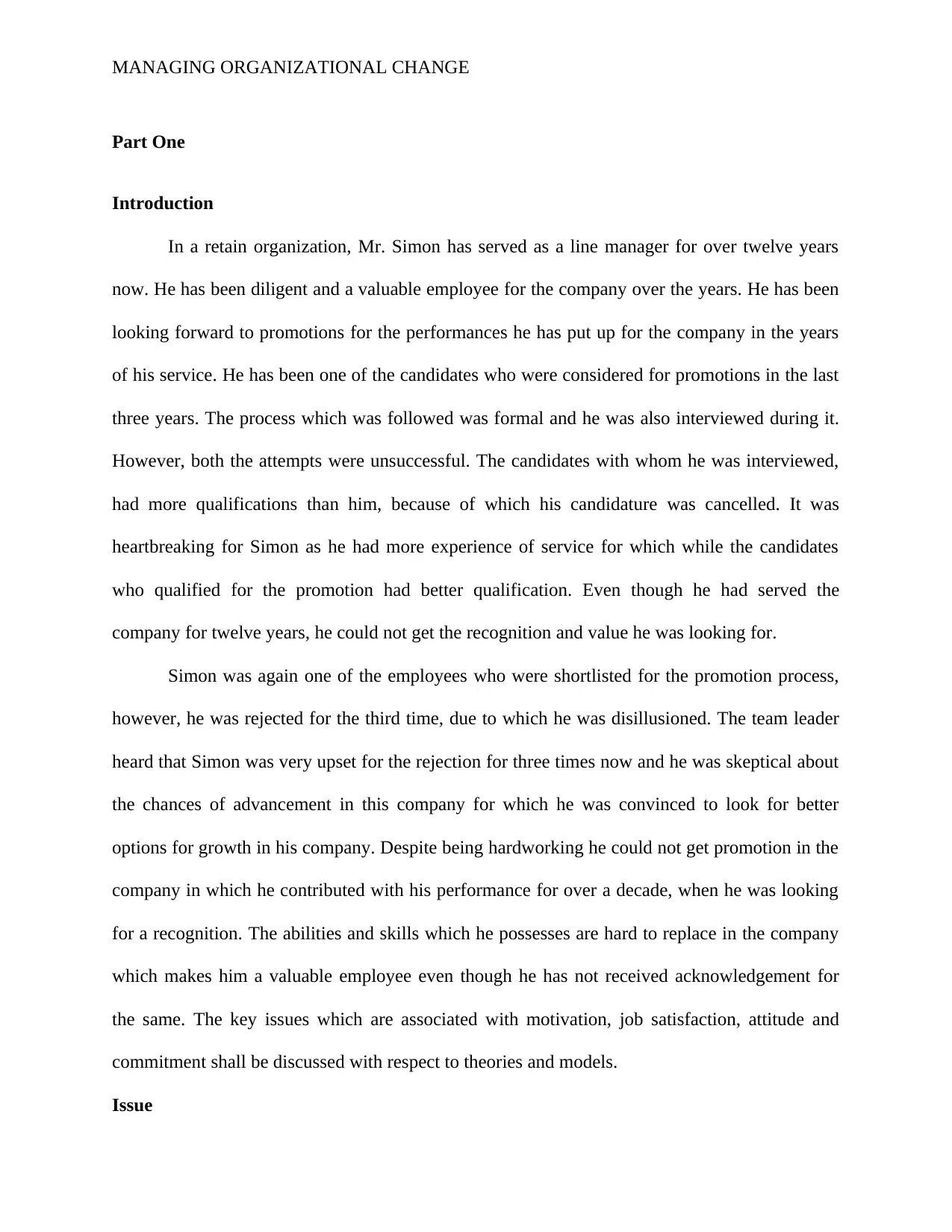
MANAGING ORGANIZATIONAL CHANGE
Part One
Introduction
In a retain organization, Mr. Simon has served as a line manager for over twelve years
now. He has been diligent and a valuable employee for the company over the years. He has been
looking forward to promotions for the performances he has put up for the company in the years
of his service. He has been one of the candidates who were considered for promotions in the last
three years. The process which was followed was formal and he was also interviewed during it.
However, both the attempts were unsuccessful. The candidates with whom he was interviewed,
had more qualifications than him, because of which his candidature was cancelled. It was
heartbreaking for Simon as he had more experience of service for which while the candidates
who qualified for the promotion had better qualification. Even though he had served the
company for twelve years, he could not get the recognition and value he was looking for.
Simon was again one of the employees who were shortlisted for the promotion process,
however, he was rejected for the third time, due to which he was disillusioned. The team leader
heard that Simon was very upset for the rejection for three times now and he was skeptical about
the chances of advancement in this company for which he was convinced to look for better
options for growth in his company. Despite being hardworking he could not get promotion in the
company in which he contributed with his performance for over a decade, when he was looking
for a recognition. The abilities and skills which he possesses are hard to replace in the company
which makes him a valuable employee even though he has not received acknowledgement for
the same. The key issues which are associated with motivation, job satisfaction, attitude and
commitment shall be discussed with respect to theories and models.
Issue
Part One
Introduction
In a retain organization, Mr. Simon has served as a line manager for over twelve years
now. He has been diligent and a valuable employee for the company over the years. He has been
looking forward to promotions for the performances he has put up for the company in the years
of his service. He has been one of the candidates who were considered for promotions in the last
three years. The process which was followed was formal and he was also interviewed during it.
However, both the attempts were unsuccessful. The candidates with whom he was interviewed,
had more qualifications than him, because of which his candidature was cancelled. It was
heartbreaking for Simon as he had more experience of service for which while the candidates
who qualified for the promotion had better qualification. Even though he had served the
company for twelve years, he could not get the recognition and value he was looking for.
Simon was again one of the employees who were shortlisted for the promotion process,
however, he was rejected for the third time, due to which he was disillusioned. The team leader
heard that Simon was very upset for the rejection for three times now and he was skeptical about
the chances of advancement in this company for which he was convinced to look for better
options for growth in his company. Despite being hardworking he could not get promotion in the
company in which he contributed with his performance for over a decade, when he was looking
for a recognition. The abilities and skills which he possesses are hard to replace in the company
which makes him a valuable employee even though he has not received acknowledgement for
the same. The key issues which are associated with motivation, job satisfaction, attitude and
commitment shall be discussed with respect to theories and models.
Issue
Paraphrase This Document
Need a fresh take? Get an instant paraphrase of this document with our AI Paraphraser
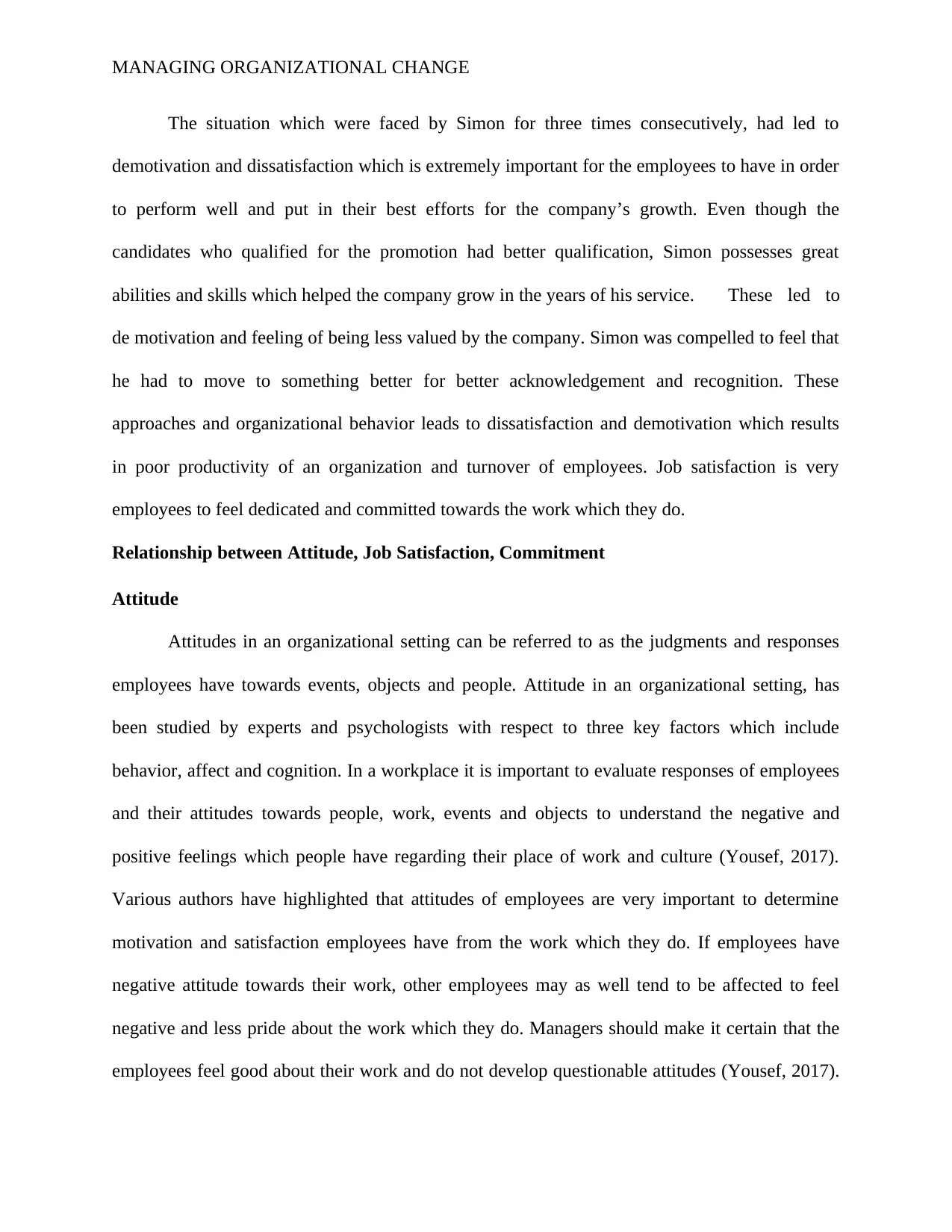
MANAGING ORGANIZATIONAL CHANGE
The situation which were faced by Simon for three times consecutively, had led to
demotivation and dissatisfaction which is extremely important for the employees to have in order
to perform well and put in their best efforts for the company’s growth. Even though the
candidates who qualified for the promotion had better qualification, Simon possesses great
abilities and skills which helped the company grow in the years of his service. These led to
de motivation and feeling of being less valued by the company. Simon was compelled to feel that
he had to move to something better for better acknowledgement and recognition. These
approaches and organizational behavior leads to dissatisfaction and demotivation which results
in poor productivity of an organization and turnover of employees. Job satisfaction is very
employees to feel dedicated and committed towards the work which they do.
Relationship between Attitude, Job Satisfaction, Commitment
Attitude
Attitudes in an organizational setting can be referred to as the judgments and responses
employees have towards events, objects and people. Attitude in an organizational setting, has
been studied by experts and psychologists with respect to three key factors which include
behavior, affect and cognition. In a workplace it is important to evaluate responses of employees
and their attitudes towards people, work, events and objects to understand the negative and
positive feelings which people have regarding their place of work and culture (Yousef, 2017).
Various authors have highlighted that attitudes of employees are very important to determine
motivation and satisfaction employees have from the work which they do. If employees have
negative attitude towards their work, other employees may as well tend to be affected to feel
negative and less pride about the work which they do. Managers should make it certain that the
employees feel good about their work and do not develop questionable attitudes (Yousef, 2017).
The situation which were faced by Simon for three times consecutively, had led to
demotivation and dissatisfaction which is extremely important for the employees to have in order
to perform well and put in their best efforts for the company’s growth. Even though the
candidates who qualified for the promotion had better qualification, Simon possesses great
abilities and skills which helped the company grow in the years of his service. These led to
de motivation and feeling of being less valued by the company. Simon was compelled to feel that
he had to move to something better for better acknowledgement and recognition. These
approaches and organizational behavior leads to dissatisfaction and demotivation which results
in poor productivity of an organization and turnover of employees. Job satisfaction is very
employees to feel dedicated and committed towards the work which they do.
Relationship between Attitude, Job Satisfaction, Commitment
Attitude
Attitudes in an organizational setting can be referred to as the judgments and responses
employees have towards events, objects and people. Attitude in an organizational setting, has
been studied by experts and psychologists with respect to three key factors which include
behavior, affect and cognition. In a workplace it is important to evaluate responses of employees
and their attitudes towards people, work, events and objects to understand the negative and
positive feelings which people have regarding their place of work and culture (Yousef, 2017).
Various authors have highlighted that attitudes of employees are very important to determine
motivation and satisfaction employees have from the work which they do. If employees have
negative attitude towards their work, other employees may as well tend to be affected to feel
negative and less pride about the work which they do. Managers should make it certain that the
employees feel good about their work and do not develop questionable attitudes (Yousef, 2017).
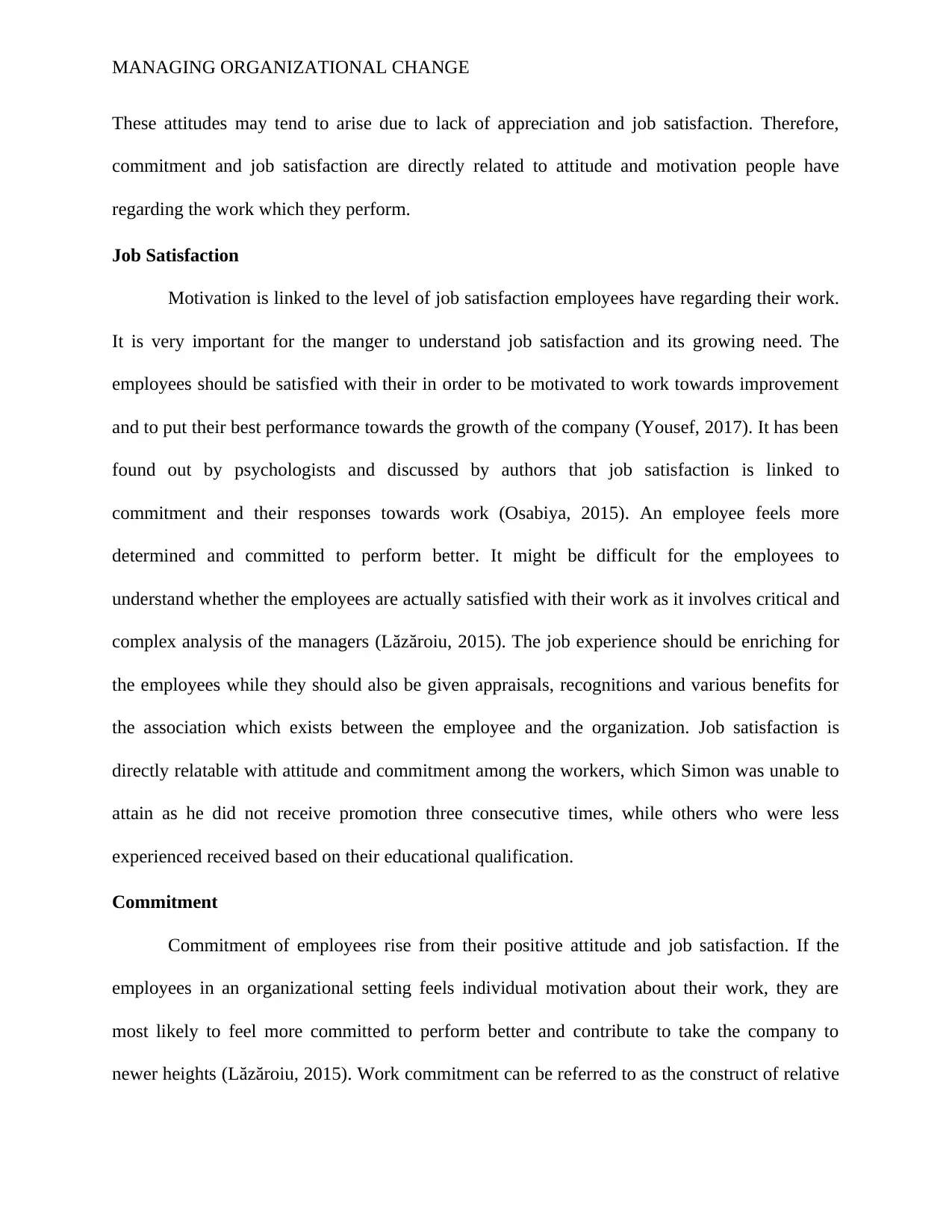
MANAGING ORGANIZATIONAL CHANGE
These attitudes may tend to arise due to lack of appreciation and job satisfaction. Therefore,
commitment and job satisfaction are directly related to attitude and motivation people have
regarding the work which they perform.
Job Satisfaction
Motivation is linked to the level of job satisfaction employees have regarding their work.
It is very important for the manger to understand job satisfaction and its growing need. The
employees should be satisfied with their in order to be motivated to work towards improvement
and to put their best performance towards the growth of the company (Yousef, 2017). It has been
found out by psychologists and discussed by authors that job satisfaction is linked to
commitment and their responses towards work (Osabiya, 2015). An employee feels more
determined and committed to perform better. It might be difficult for the employees to
understand whether the employees are actually satisfied with their work as it involves critical and
complex analysis of the managers (Lăzăroiu, 2015). The job experience should be enriching for
the employees while they should also be given appraisals, recognitions and various benefits for
the association which exists between the employee and the organization. Job satisfaction is
directly relatable with attitude and commitment among the workers, which Simon was unable to
attain as he did not receive promotion three consecutive times, while others who were less
experienced received based on their educational qualification.
Commitment
Commitment of employees rise from their positive attitude and job satisfaction. If the
employees in an organizational setting feels individual motivation about their work, they are
most likely to feel more committed to perform better and contribute to take the company to
newer heights (Lăzăroiu, 2015). Work commitment can be referred to as the construct of relative
These attitudes may tend to arise due to lack of appreciation and job satisfaction. Therefore,
commitment and job satisfaction are directly related to attitude and motivation people have
regarding the work which they perform.
Job Satisfaction
Motivation is linked to the level of job satisfaction employees have regarding their work.
It is very important for the manger to understand job satisfaction and its growing need. The
employees should be satisfied with their in order to be motivated to work towards improvement
and to put their best performance towards the growth of the company (Yousef, 2017). It has been
found out by psychologists and discussed by authors that job satisfaction is linked to
commitment and their responses towards work (Osabiya, 2015). An employee feels more
determined and committed to perform better. It might be difficult for the employees to
understand whether the employees are actually satisfied with their work as it involves critical and
complex analysis of the managers (Lăzăroiu, 2015). The job experience should be enriching for
the employees while they should also be given appraisals, recognitions and various benefits for
the association which exists between the employee and the organization. Job satisfaction is
directly relatable with attitude and commitment among the workers, which Simon was unable to
attain as he did not receive promotion three consecutive times, while others who were less
experienced received based on their educational qualification.
Commitment
Commitment of employees rise from their positive attitude and job satisfaction. If the
employees in an organizational setting feels individual motivation about their work, they are
most likely to feel more committed to perform better and contribute to take the company to
newer heights (Lăzăroiu, 2015). Work commitment can be referred to as the construct of relative
⊘ This is a preview!⊘
Do you want full access?
Subscribe today to unlock all pages.

Trusted by 1+ million students worldwide
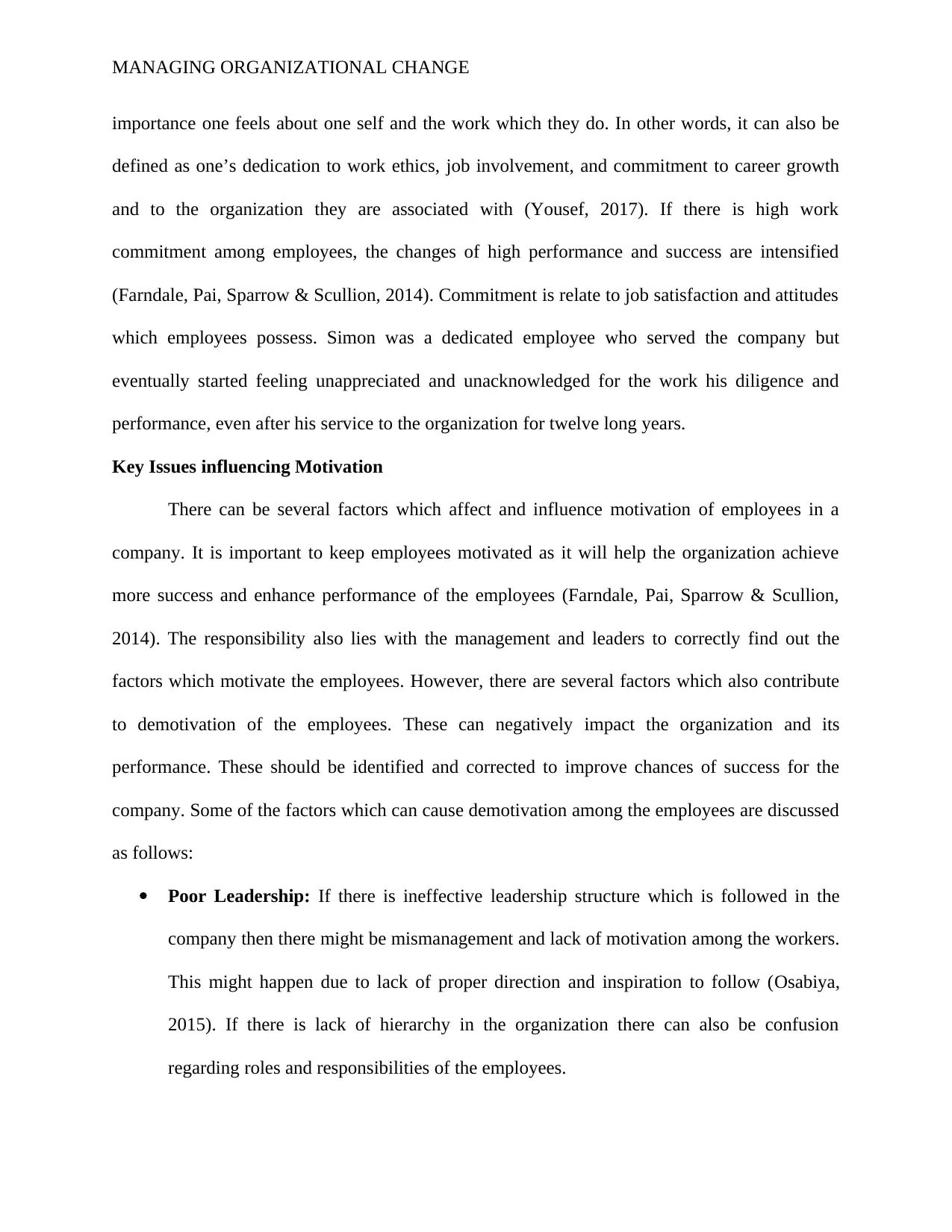
MANAGING ORGANIZATIONAL CHANGE
importance one feels about one self and the work which they do. In other words, it can also be
defined as one’s dedication to work ethics, job involvement, and commitment to career growth
and to the organization they are associated with (Yousef, 2017). If there is high work
commitment among employees, the changes of high performance and success are intensified
(Farndale, Pai, Sparrow & Scullion, 2014). Commitment is relate to job satisfaction and attitudes
which employees possess. Simon was a dedicated employee who served the company but
eventually started feeling unappreciated and unacknowledged for the work his diligence and
performance, even after his service to the organization for twelve long years.
Key Issues influencing Motivation
There can be several factors which affect and influence motivation of employees in a
company. It is important to keep employees motivated as it will help the organization achieve
more success and enhance performance of the employees (Farndale, Pai, Sparrow & Scullion,
2014). The responsibility also lies with the management and leaders to correctly find out the
factors which motivate the employees. However, there are several factors which also contribute
to demotivation of the employees. These can negatively impact the organization and its
performance. These should be identified and corrected to improve chances of success for the
company. Some of the factors which can cause demotivation among the employees are discussed
as follows:
Poor Leadership: If there is ineffective leadership structure which is followed in the
company then there might be mismanagement and lack of motivation among the workers.
This might happen due to lack of proper direction and inspiration to follow (Osabiya,
2015). If there is lack of hierarchy in the organization there can also be confusion
regarding roles and responsibilities of the employees.
importance one feels about one self and the work which they do. In other words, it can also be
defined as one’s dedication to work ethics, job involvement, and commitment to career growth
and to the organization they are associated with (Yousef, 2017). If there is high work
commitment among employees, the changes of high performance and success are intensified
(Farndale, Pai, Sparrow & Scullion, 2014). Commitment is relate to job satisfaction and attitudes
which employees possess. Simon was a dedicated employee who served the company but
eventually started feeling unappreciated and unacknowledged for the work his diligence and
performance, even after his service to the organization for twelve long years.
Key Issues influencing Motivation
There can be several factors which affect and influence motivation of employees in a
company. It is important to keep employees motivated as it will help the organization achieve
more success and enhance performance of the employees (Farndale, Pai, Sparrow & Scullion,
2014). The responsibility also lies with the management and leaders to correctly find out the
factors which motivate the employees. However, there are several factors which also contribute
to demotivation of the employees. These can negatively impact the organization and its
performance. These should be identified and corrected to improve chances of success for the
company. Some of the factors which can cause demotivation among the employees are discussed
as follows:
Poor Leadership: If there is ineffective leadership structure which is followed in the
company then there might be mismanagement and lack of motivation among the workers.
This might happen due to lack of proper direction and inspiration to follow (Osabiya,
2015). If there is lack of hierarchy in the organization there can also be confusion
regarding roles and responsibilities of the employees.
Paraphrase This Document
Need a fresh take? Get an instant paraphrase of this document with our AI Paraphraser
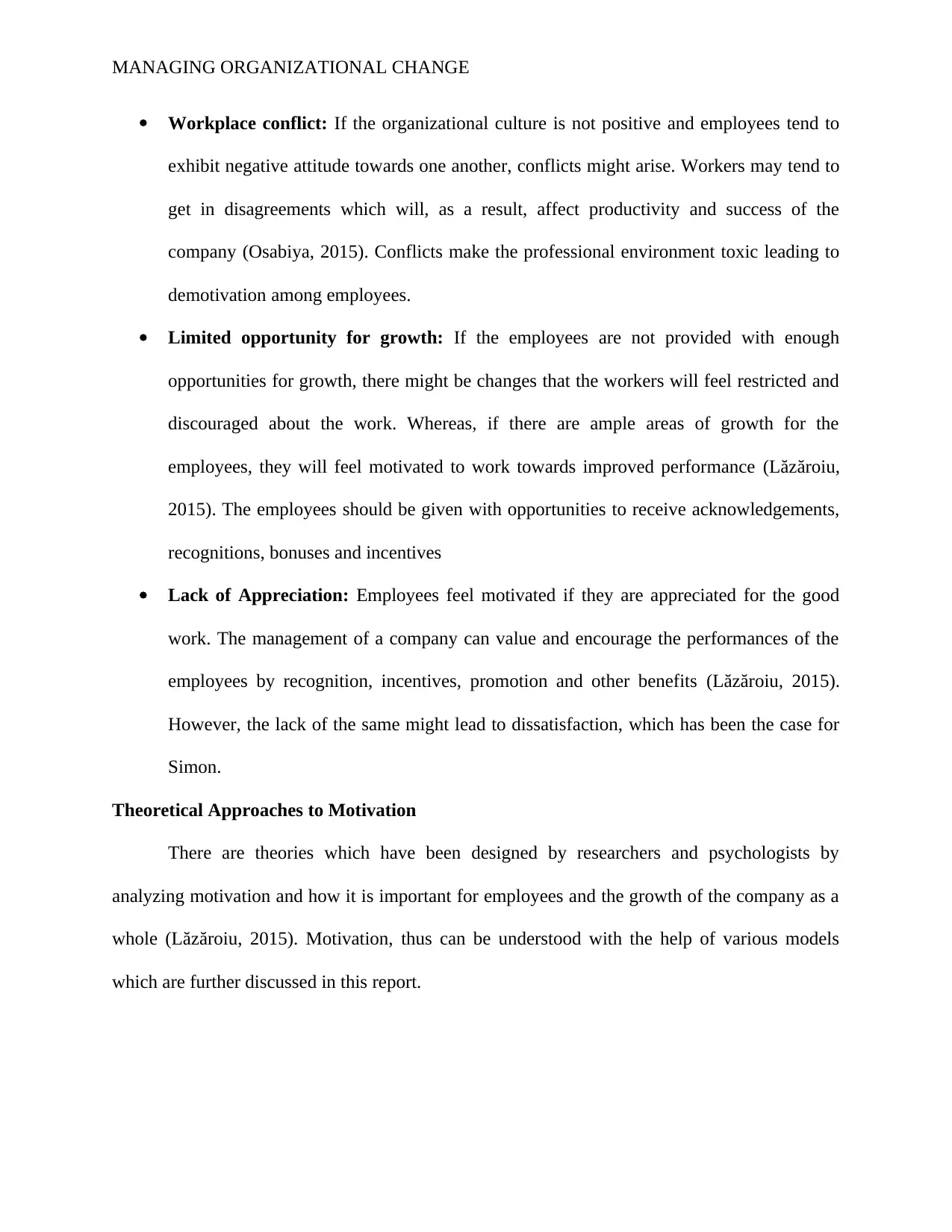
MANAGING ORGANIZATIONAL CHANGE
Workplace conflict: If the organizational culture is not positive and employees tend to
exhibit negative attitude towards one another, conflicts might arise. Workers may tend to
get in disagreements which will, as a result, affect productivity and success of the
company (Osabiya, 2015). Conflicts make the professional environment toxic leading to
demotivation among employees.
Limited opportunity for growth: If the employees are not provided with enough
opportunities for growth, there might be changes that the workers will feel restricted and
discouraged about the work. Whereas, if there are ample areas of growth for the
employees, they will feel motivated to work towards improved performance (Lăzăroiu,
2015). The employees should be given with opportunities to receive acknowledgements,
recognitions, bonuses and incentives
Lack of Appreciation: Employees feel motivated if they are appreciated for the good
work. The management of a company can value and encourage the performances of the
employees by recognition, incentives, promotion and other benefits (Lăzăroiu, 2015).
However, the lack of the same might lead to dissatisfaction, which has been the case for
Simon.
Theoretical Approaches to Motivation
There are theories which have been designed by researchers and psychologists by
analyzing motivation and how it is important for employees and the growth of the company as a
whole (Lăzăroiu, 2015). Motivation, thus can be understood with the help of various models
which are further discussed in this report.
Workplace conflict: If the organizational culture is not positive and employees tend to
exhibit negative attitude towards one another, conflicts might arise. Workers may tend to
get in disagreements which will, as a result, affect productivity and success of the
company (Osabiya, 2015). Conflicts make the professional environment toxic leading to
demotivation among employees.
Limited opportunity for growth: If the employees are not provided with enough
opportunities for growth, there might be changes that the workers will feel restricted and
discouraged about the work. Whereas, if there are ample areas of growth for the
employees, they will feel motivated to work towards improved performance (Lăzăroiu,
2015). The employees should be given with opportunities to receive acknowledgements,
recognitions, bonuses and incentives
Lack of Appreciation: Employees feel motivated if they are appreciated for the good
work. The management of a company can value and encourage the performances of the
employees by recognition, incentives, promotion and other benefits (Lăzăroiu, 2015).
However, the lack of the same might lead to dissatisfaction, which has been the case for
Simon.
Theoretical Approaches to Motivation
There are theories which have been designed by researchers and psychologists by
analyzing motivation and how it is important for employees and the growth of the company as a
whole (Lăzăroiu, 2015). Motivation, thus can be understood with the help of various models
which are further discussed in this report.
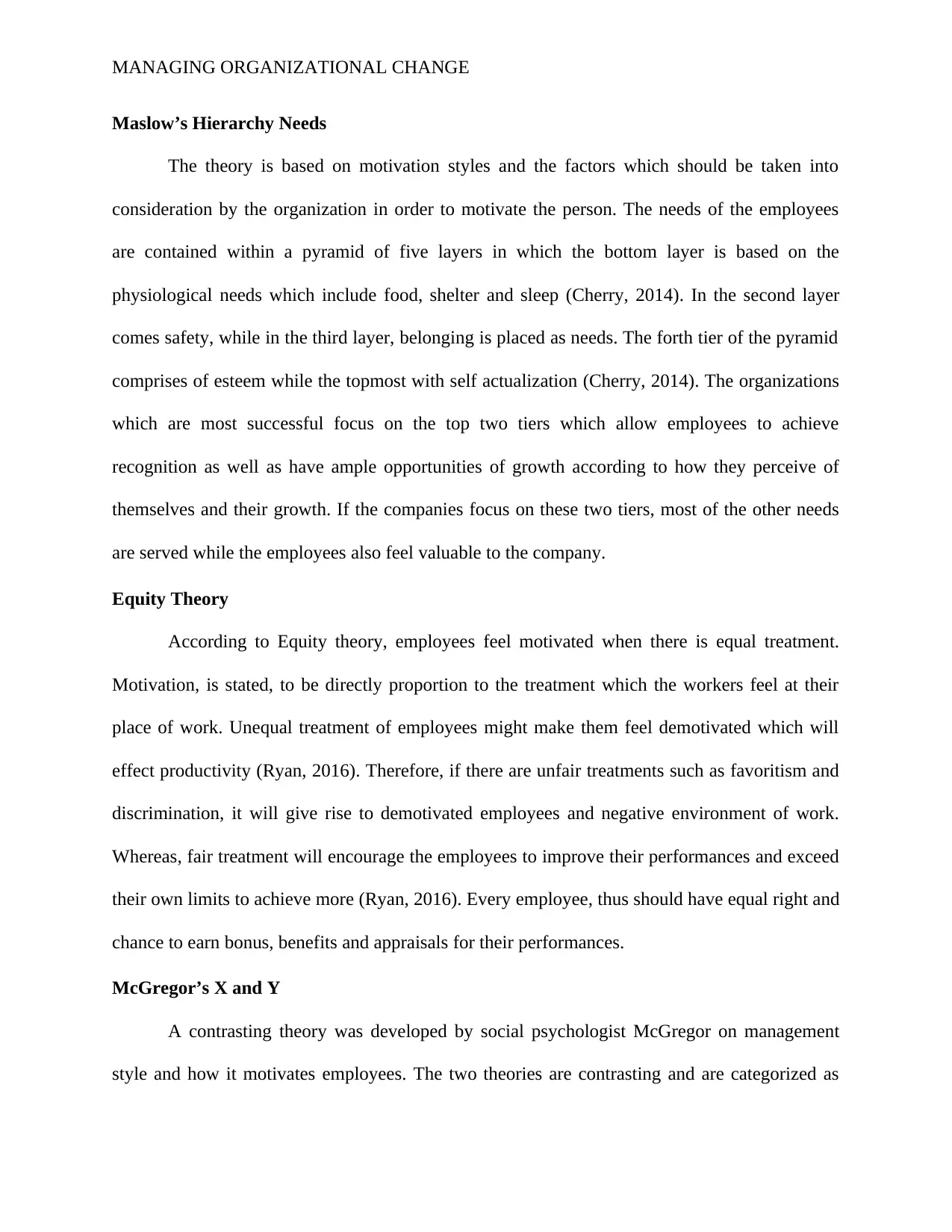
MANAGING ORGANIZATIONAL CHANGE
Maslow’s Hierarchy Needs
The theory is based on motivation styles and the factors which should be taken into
consideration by the organization in order to motivate the person. The needs of the employees
are contained within a pyramid of five layers in which the bottom layer is based on the
physiological needs which include food, shelter and sleep (Cherry, 2014). In the second layer
comes safety, while in the third layer, belonging is placed as needs. The forth tier of the pyramid
comprises of esteem while the topmost with self actualization (Cherry, 2014). The organizations
which are most successful focus on the top two tiers which allow employees to achieve
recognition as well as have ample opportunities of growth according to how they perceive of
themselves and their growth. If the companies focus on these two tiers, most of the other needs
are served while the employees also feel valuable to the company.
Equity Theory
According to Equity theory, employees feel motivated when there is equal treatment.
Motivation, is stated, to be directly proportion to the treatment which the workers feel at their
place of work. Unequal treatment of employees might make them feel demotivated which will
effect productivity (Ryan, 2016). Therefore, if there are unfair treatments such as favoritism and
discrimination, it will give rise to demotivated employees and negative environment of work.
Whereas, fair treatment will encourage the employees to improve their performances and exceed
their own limits to achieve more (Ryan, 2016). Every employee, thus should have equal right and
chance to earn bonus, benefits and appraisals for their performances.
McGregor’s X and Y
A contrasting theory was developed by social psychologist McGregor on management
style and how it motivates employees. The two theories are contrasting and are categorized as
Maslow’s Hierarchy Needs
The theory is based on motivation styles and the factors which should be taken into
consideration by the organization in order to motivate the person. The needs of the employees
are contained within a pyramid of five layers in which the bottom layer is based on the
physiological needs which include food, shelter and sleep (Cherry, 2014). In the second layer
comes safety, while in the third layer, belonging is placed as needs. The forth tier of the pyramid
comprises of esteem while the topmost with self actualization (Cherry, 2014). The organizations
which are most successful focus on the top two tiers which allow employees to achieve
recognition as well as have ample opportunities of growth according to how they perceive of
themselves and their growth. If the companies focus on these two tiers, most of the other needs
are served while the employees also feel valuable to the company.
Equity Theory
According to Equity theory, employees feel motivated when there is equal treatment.
Motivation, is stated, to be directly proportion to the treatment which the workers feel at their
place of work. Unequal treatment of employees might make them feel demotivated which will
effect productivity (Ryan, 2016). Therefore, if there are unfair treatments such as favoritism and
discrimination, it will give rise to demotivated employees and negative environment of work.
Whereas, fair treatment will encourage the employees to improve their performances and exceed
their own limits to achieve more (Ryan, 2016). Every employee, thus should have equal right and
chance to earn bonus, benefits and appraisals for their performances.
McGregor’s X and Y
A contrasting theory was developed by social psychologist McGregor on management
style and how it motivates employees. The two theories are contrasting and are categorized as
⊘ This is a preview!⊘
Do you want full access?
Subscribe today to unlock all pages.

Trusted by 1+ million students worldwide
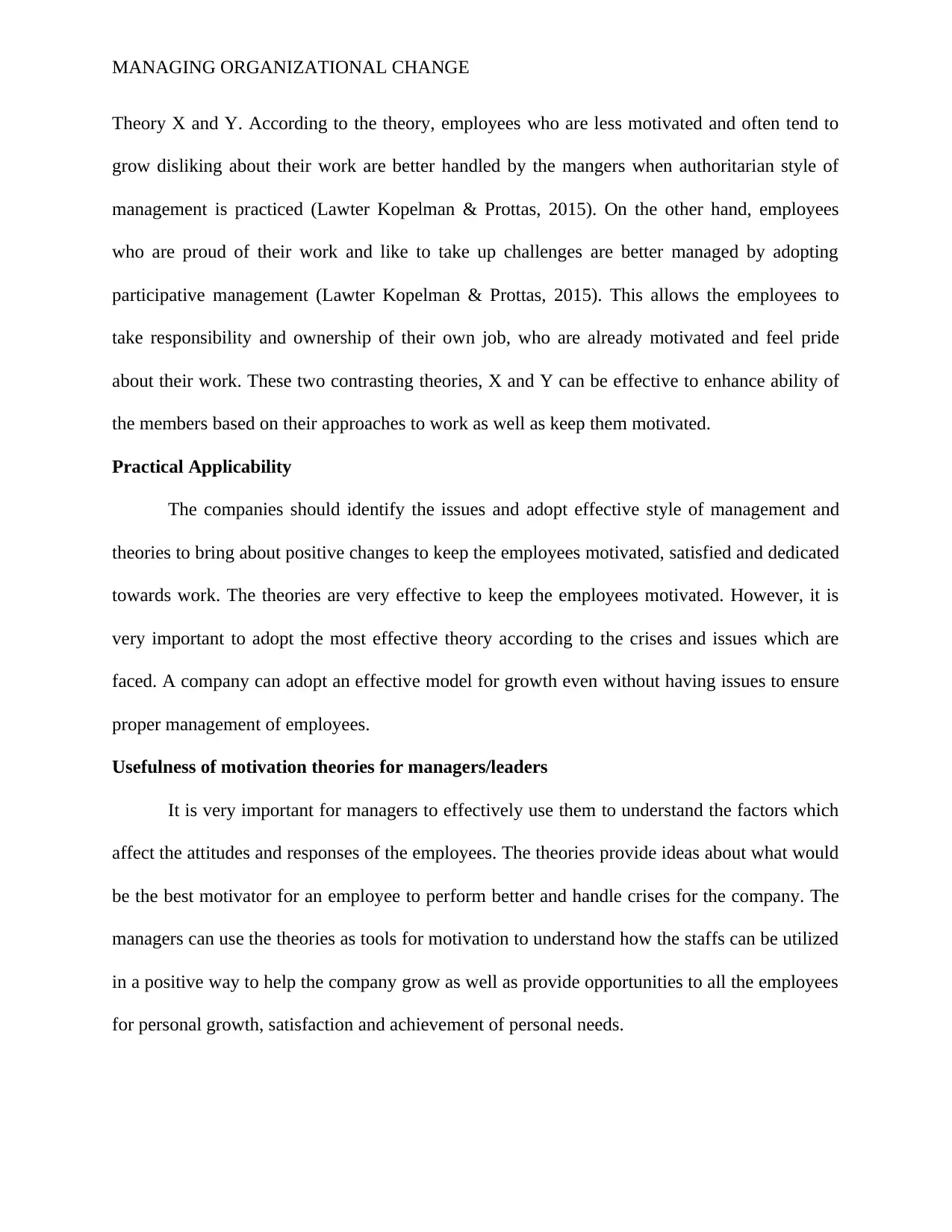
MANAGING ORGANIZATIONAL CHANGE
Theory X and Y. According to the theory, employees who are less motivated and often tend to
grow disliking about their work are better handled by the mangers when authoritarian style of
management is practiced (Lawter Kopelman & Prottas, 2015). On the other hand, employees
who are proud of their work and like to take up challenges are better managed by adopting
participative management (Lawter Kopelman & Prottas, 2015). This allows the employees to
take responsibility and ownership of their own job, who are already motivated and feel pride
about their work. These two contrasting theories, X and Y can be effective to enhance ability of
the members based on their approaches to work as well as keep them motivated.
Practical Applicability
The companies should identify the issues and adopt effective style of management and
theories to bring about positive changes to keep the employees motivated, satisfied and dedicated
towards work. The theories are very effective to keep the employees motivated. However, it is
very important to adopt the most effective theory according to the crises and issues which are
faced. A company can adopt an effective model for growth even without having issues to ensure
proper management of employees.
Usefulness of motivation theories for managers/leaders
It is very important for managers to effectively use them to understand the factors which
affect the attitudes and responses of the employees. The theories provide ideas about what would
be the best motivator for an employee to perform better and handle crises for the company. The
managers can use the theories as tools for motivation to understand how the staffs can be utilized
in a positive way to help the company grow as well as provide opportunities to all the employees
for personal growth, satisfaction and achievement of personal needs.
Theory X and Y. According to the theory, employees who are less motivated and often tend to
grow disliking about their work are better handled by the mangers when authoritarian style of
management is practiced (Lawter Kopelman & Prottas, 2015). On the other hand, employees
who are proud of their work and like to take up challenges are better managed by adopting
participative management (Lawter Kopelman & Prottas, 2015). This allows the employees to
take responsibility and ownership of their own job, who are already motivated and feel pride
about their work. These two contrasting theories, X and Y can be effective to enhance ability of
the members based on their approaches to work as well as keep them motivated.
Practical Applicability
The companies should identify the issues and adopt effective style of management and
theories to bring about positive changes to keep the employees motivated, satisfied and dedicated
towards work. The theories are very effective to keep the employees motivated. However, it is
very important to adopt the most effective theory according to the crises and issues which are
faced. A company can adopt an effective model for growth even without having issues to ensure
proper management of employees.
Usefulness of motivation theories for managers/leaders
It is very important for managers to effectively use them to understand the factors which
affect the attitudes and responses of the employees. The theories provide ideas about what would
be the best motivator for an employee to perform better and handle crises for the company. The
managers can use the theories as tools for motivation to understand how the staffs can be utilized
in a positive way to help the company grow as well as provide opportunities to all the employees
for personal growth, satisfaction and achievement of personal needs.
Paraphrase This Document
Need a fresh take? Get an instant paraphrase of this document with our AI Paraphraser
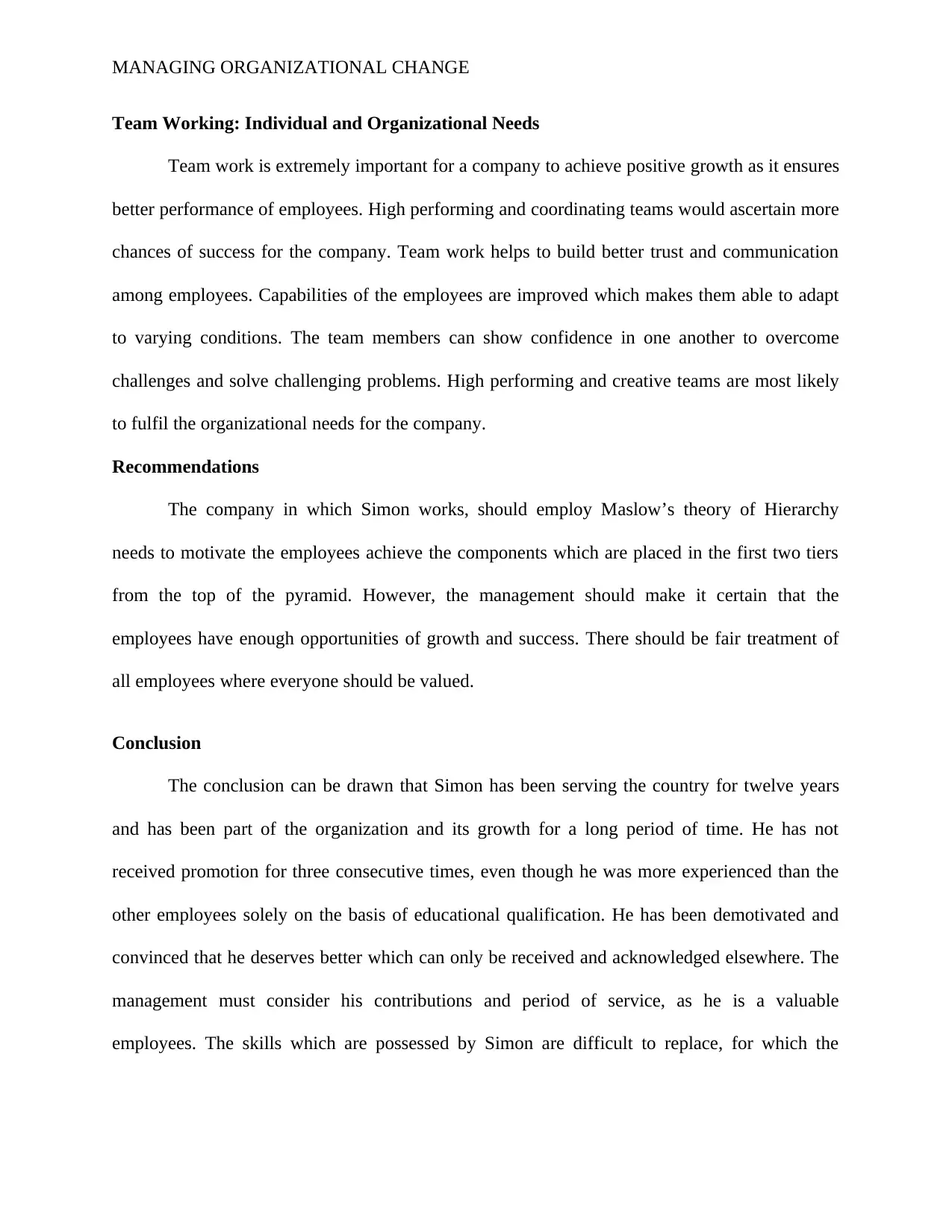
MANAGING ORGANIZATIONAL CHANGE
Team Working: Individual and Organizational Needs
Team work is extremely important for a company to achieve positive growth as it ensures
better performance of employees. High performing and coordinating teams would ascertain more
chances of success for the company. Team work helps to build better trust and communication
among employees. Capabilities of the employees are improved which makes them able to adapt
to varying conditions. The team members can show confidence in one another to overcome
challenges and solve challenging problems. High performing and creative teams are most likely
to fulfil the organizational needs for the company.
Recommendations
The company in which Simon works, should employ Maslow’s theory of Hierarchy
needs to motivate the employees achieve the components which are placed in the first two tiers
from the top of the pyramid. However, the management should make it certain that the
employees have enough opportunities of growth and success. There should be fair treatment of
all employees where everyone should be valued.
Conclusion
The conclusion can be drawn that Simon has been serving the country for twelve years
and has been part of the organization and its growth for a long period of time. He has not
received promotion for three consecutive times, even though he was more experienced than the
other employees solely on the basis of educational qualification. He has been demotivated and
convinced that he deserves better which can only be received and acknowledged elsewhere. The
management must consider his contributions and period of service, as he is a valuable
employees. The skills which are possessed by Simon are difficult to replace, for which the
Team Working: Individual and Organizational Needs
Team work is extremely important for a company to achieve positive growth as it ensures
better performance of employees. High performing and coordinating teams would ascertain more
chances of success for the company. Team work helps to build better trust and communication
among employees. Capabilities of the employees are improved which makes them able to adapt
to varying conditions. The team members can show confidence in one another to overcome
challenges and solve challenging problems. High performing and creative teams are most likely
to fulfil the organizational needs for the company.
Recommendations
The company in which Simon works, should employ Maslow’s theory of Hierarchy
needs to motivate the employees achieve the components which are placed in the first two tiers
from the top of the pyramid. However, the management should make it certain that the
employees have enough opportunities of growth and success. There should be fair treatment of
all employees where everyone should be valued.
Conclusion
The conclusion can be drawn that Simon has been serving the country for twelve years
and has been part of the organization and its growth for a long period of time. He has not
received promotion for three consecutive times, even though he was more experienced than the
other employees solely on the basis of educational qualification. He has been demotivated and
convinced that he deserves better which can only be received and acknowledged elsewhere. The
management must consider his contributions and period of service, as he is a valuable
employees. The skills which are possessed by Simon are difficult to replace, for which the

MANAGING ORGANIZATIONAL CHANGE
company must adopt the most effective theory for motivation, which can be Maslow’s Hierarchy
needs. .
company must adopt the most effective theory for motivation, which can be Maslow’s Hierarchy
needs. .
⊘ This is a preview!⊘
Do you want full access?
Subscribe today to unlock all pages.

Trusted by 1+ million students worldwide
1 out of 22
Related Documents
Your All-in-One AI-Powered Toolkit for Academic Success.
+13062052269
info@desklib.com
Available 24*7 on WhatsApp / Email
![[object Object]](/_next/static/media/star-bottom.7253800d.svg)
Unlock your academic potential
Copyright © 2020–2025 A2Z Services. All Rights Reserved. Developed and managed by ZUCOL.




